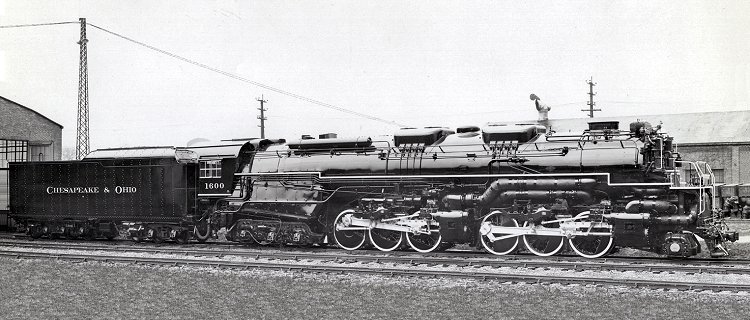In 1941 Lima Locomotive Works delivered the first group of 2-6-6-6 simple articulated locomotives to the Chesapeake & Ohio. These were the first locomotives to be erected with this wheel arrangement, and the C&O styled them the "Allegheny" type. Their weight without tender was initially given as around 752,000 pounds (the C&O order specified 726,000 pounds). However it was later revealed that their true weight was some 778,000 pounds making them the heaviest locomotives ever built, surpassing even the Union Pacific's famous "Big Boy" 4-8-8-4. The Allegheny's axle load was the highest ever to be placed on rails. The tender alone weighed more than many modern steam locomotives, and the weight of the water compartment required a four-axle rear truck.
The Lima design incorporated a firebox so large, at 135 square feet of grate area, that it required a three-axle trailing truck for support. Such a six-wheel truck appeared only on two modern steam designs, the Pennsylvania Railroad's S-1 6-4-4-6 and the S-2 direct drive steam turbine 6-8-6 (see Modern Power for Today's Trains in this Rail Archive). A few older engines had them, such as the Boston & Albany 2-6-6T suburban double-enders that used a small six-wheel truck under the tank portion. Although this builder's photo of C&O No. 1600 makes it appear that the rear truck employed solid journal bearings, all the Allegheny's axles turned on Timken roller bearings. With its mammoth firebox and extra-large evaporative heating surface (7240 square feet) and superheater surface (3186 square feet), the 2-6-6-6 boiler was capable of delivering up to 7500 horsepower at 40 miles per hour, the equivalent of about five contemporary diesel units. Some of them were equipped with steam heat and signal lines for passenger service. However, the C&O used these engines mainly on coal drags where their high-speed capabilities were underutilized.
The C&O 2-6-6-6 had 67-inch drivers, four 22½x33-inch cylinders, and a boiler pressure of 260 p.s.i. These locomotives developed 110,200 pounds of tractive effort. The C&O eventually owned 60 of these locomotives, the final group coming from Lima in 1944. They were taken out of service beginning in 1952, and all were retired by 1956. Two of them survive in museums.
